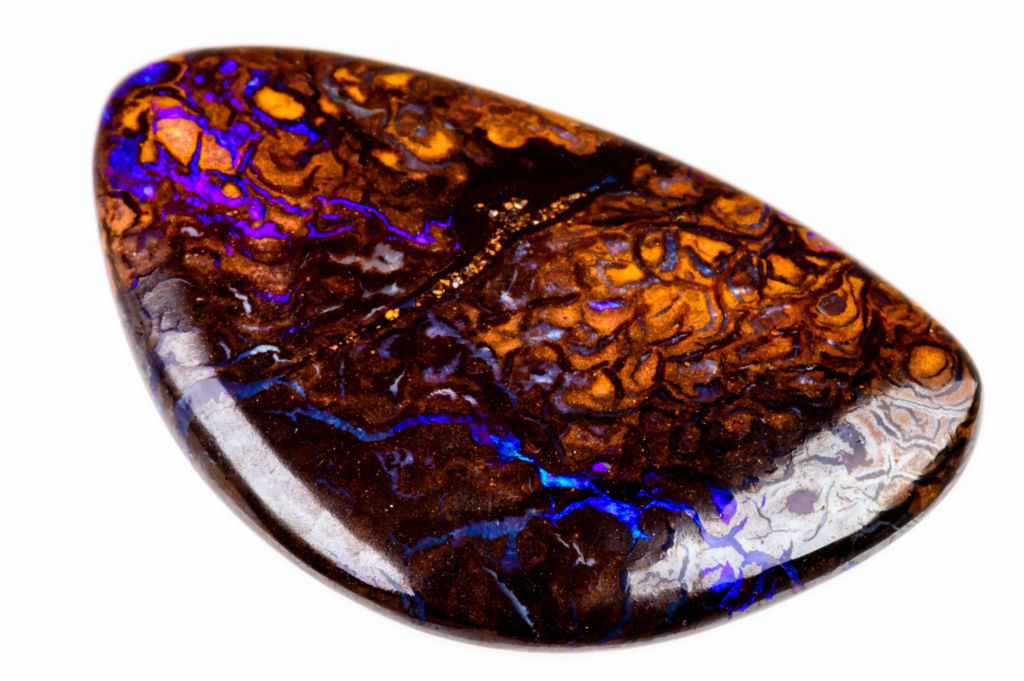
Like most gem stones, glamorous opals are valued based on their color, cut, clarity and size, but the criteria for this jewel is a little different. First and foremost, the type of opal affects the value significantly.
What are Precious Opals?
For an opal to be classified as precious, it must display a bright and impressive “play of color”. This refers to the splashes of bright, colored light that flash inside the gem.
There are two types of precious opals: crystal opals, and black opals.
The “crystal opal” is where the precious opal’s play of color happens on a light backing, where as a “black opal” displays its color on (as per the name) a black backdrop. Black opals are considered to be more desirable and are only mined in Australia, thereby lifting their value above the “crystal” variety. As the rarest form, black opal is priced comparably to diamonds on a dollars per carat basis regardless of the cut.
Boulder Opals
In some parts of the world, opal grows in ironstone rock, giving bright flashes of color through it. “Boulder opal” refers to whole chunks of ironstone that have been cut off and polished, displaying the opal’s play of color throughout. Next to the precious opals, this type is the second-most valuable.
Common Opals
A common opal has all of the properties of a precious opal, except for the exquisite play of color beneath the surface. They are generally found in shades of red, orange, yellow and white. The intensity of the color in a common opal will greatly effect its value.
Once the type of opal has been established, the four C’s then determine its value:
What Color are Opals?
Regardless of type, the play of color in an opal is the most important aspect when it comes to assessing its value. Bright sparks of a wide spectrum of color should be at play under the surface and deep inside the opal. The deeper that the bright splashes of color extend, the more valuable the gem. In common opals, the more intense the base color, the better. Red and orange are the most valuable and are sometimes referred to as “fire opals”.
What to look for in a well-cut Opal?
In opal pricing, the more transparent the stone, the higher its value. Without a good transparency, the play of color won’t be as visible. Look for an opal that has few inclusions and no cracks, with an almost glass-like “window” into the colors below.
As it can be up to 30% water, precious opal is exceptionally sensitive to drying and can unpredictably “craze” (crack) at any time, most often during the cutting process. Well-cut, quality opal is therefore expensive – but can make for a very memorable gift. The caution that must be exercised in cutting, polishing and setting it into jewelry requires the skill and experience of a master craftsman.
However, common opals are often faceted in traditional shapes without losing their integrity. These are often the red and orange varieties, referred to as “fire opals” The cutting and polishing of these less expensive opals increases their aesthetic appeal and therefor their value.
Are Opals Expensive?
The value-to-size ratio of this gemstone depends entirely on what type of opal you have. Good opal crystal can vary between $200 and $1800 dollars a carat but poorer quality opals are readily available at a much cheaper cost.
Uses, History & Mythology
Often used in jewellery, opals are set in rings, earrings, necklaces and even watch-faces. They are also sold as-is to gem collectors and whilst opal has no industrial or commercial use, good specimens are highly sought after by museums.
In the Middle Ages, opals were believed to possess all the virtues of each gemstone whose color was represented in the spectrum of the particular opal being held. Because of this, the opal was considered to provide great luck and good protection.
Now days, opal is the birthstone for those both in October and is often given as a gift, either set in jewelry or kept in an ornate jewel box.
